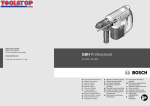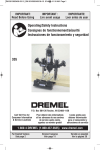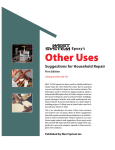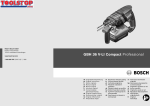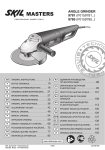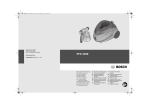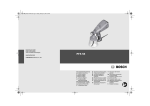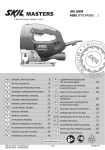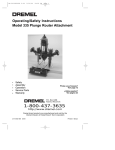Download Dremel 335 Operating instructions
Transcript
Model 335 Plunge Router Attachment GB 6 CZ Původním návodem k používání 62 D Originalbetriebsanleitung 10 PL Instrukcja obsługi 66 F Notice originale 14 BG Оригинално ръководство за експлоатация 71 I Istruzioni originali 19 H NL Originele gebruiksaanwijzing 23 RO DK Original brugsanvisning 28 RUS Одлинник руководства по эксплуатации 84 S Bruksanvisning i original 32 EST Algupärane kasutusjuhend 89 N Original driftsinstruks 36 LT Originali instrukcija 93 Izvirna navodila 97 FIN Original instructions Eredeti használati utasítás 75 Instrucţiuni de folosire originale 80 Alkuperäiset käyttö-/turvallisuusohjeet 40 SLO E Manual original 44 LV Instrukcijām oriģinālvalodā 101 P Manual original 49 HR Originalne upute za rad 105 GR Οδηγίες χρήσης 53 SRB Оригинално упутство за рад 110 TR Orijinal kullanım kılavuzu 58 SK Pôvodný návod na použitie 114 Dremel Europe The Netherlands 2610004523 190309 www.dremel.com All Rights Reserved 1 L FIG. 1 M A N B C K D J E I F G H 2 3 A A B C 4B 4A 9.65 mm 9.65 mm 6.4 mm 3.2 mm 4.8 mm 612 615 640 650 652 2615061232 2615061532 2615064032 2615065032 2615065232 6.4 mm 7.5 mm 654 655 2615065432 26150655JA A B C D A 5 8 B X A B C X 6FIG. 6 9 x1 A B A A 10 7 A X B B X C 3 11 B A I C D E F G H 12 13 A A B B 4 14 15 B A A C D E G B C 5 F GB GENERAL SAFETY INSTRUCTIONS g.If devices are provided for the connection of dust extraction and collection facilities, ensure these are connected and properly used. Use of these devices can reduce dust related hazards. h. Do not work materials containing asbestos (asbestos is considered carcinogenic). i.Take protective measures when during work dust can develop that is harmful to one's health, combustible or explosive (some dusts are considered carcinogenic); wear a dust mask and work with dust/ chip extraction when connectable. READ ALL INSTRUCTIONS. Failure to follow all instructions listed below may result in electric shock, fire and/or serious injury. The term “power tool” in all of the warnings listed below refers to your mains-operated (corded) power tool. ! WARNING SAVE THESE INSTRUCTIONS POWER TOOL USE AND CARE WORK AREA a.Do not force the power tool. Use the correct power tool for your application. The correct power tool will do the job better and safer at the rate for which it was designed. b.Do not use the power tool if the switch does not switch it on and off. Any power tool that cannot be controlled with the switch is dangerous and must be repaired. c.Disconnect the plug from the power source before making any adjustments, changing accessories, or storing power tools. Such preventive safety measures reduce the risk of starting the power tool accidentally. d.Store idle power tools out of the reach of children and do not allow persons unfamiliar with the power tool or these instructions to operate the power tool. Power tools are dangerous in the hands of untrained users. e.Maintain power tools. Check for misalignment or binding of moving parts, breakage of parts and any other condition that may affect the power tools operation. If damaged, have the power tool repaired before use. Many accidents are caused by poorly maintained power tools. f.Keep cutting tools sharp and clean. Properly maintained cutting tools with sharp cutting edges are less likely to bind and are easier to control. g.Use the power tool, accessories and tool bits etc., in accordance with these instructions and in the manner intended for the particular type of power tool, taking into account the working conditions and the work to be performed. Use of the power tool for operations different from those intended could result in a hazardous situation. a.Keep work area clean and well lit. Cluttered and dark areas invite accidents. b.Do not operate power tools in explosive atmospheres, such as in the presence of flammable liquids, gases or dust. Power tools create sparks which may ignite the dust or fumes. c.Keep children and bystanders away while operating a power tool. Distractions can cause you to lose control. ELECTRICAL SAFETY a.Power tool plugs must match the outlet. Never modify the plug in any way. Do not use any adapter plugs with earthed (grounded) power tools. Unmodified plugs and matching outlets will reduce risk of electric shock. b.Avoid body contact with earthed or grounded surfaces such as pipes, radiators, ranges and refrigerators. There is an increased risk of electric shock if your body is earthed or grounded. c.Do not expose power tools to rain or wet conditions. Water entering a power tool will increase the risk of electric shock. d.Do not abuse the cord. Never use the cord for carrying, pulling or unplugging the power tool. Keep cord away from heat, oil, sharp edges or moving parts. Damaged or entangled cords increase the risk of electric shock. e.When operating a power tool outdoors, use an extension cord suitable for outdoor use. Use of a cord suitable for outdoor use reduces the risk of electric shock. f. If operating a power tool in a damp location is unavoidable, use an earth leakage circuit breaker. Use of an earth leakage circuit breaker reduces the risk of electric shock. SERVICE a.Have your power tool serviced by a qualified repair person using only identical replacement parts. This will ensure that the safety of the power tool is maintained. PERSONAL SAFETY a.Stay alert, watch what you are doing and use common sense when operating a power tool. Do not use a power tool while you are tired or under the influence of drugs, alcohol or medication. A moment of inattention while operating power tools may result in serious personal injury. Use safety equipment. Always wear eye protection. b. Safety equipment such as dust mask, non-skid safety shoes, hard hat, or hearing protection used for appropriate conditions will reduce personal injuries. c.Avoid accidental starting. Ensure the switch is in the off position before plugging in. Carrying power tools with your finger on the switch or plugging in power tools that have the switch on invites accidents. d.Remove any adjusting key or wrench before switching the power tool on. A wrench or a key left attached to a rotating part of the power tool may result in personal injury. e.Do not overreach. Keep proper footing and balance at all times. This enables better control of the power tool in unexpected situations. f.Dress properly. Do not wear loose clothing or jewellery. Keep your hair, clothing and gloves away from moving parts. Loose clothes, jewellery or long hair can be caught in moving parts. SAFETY INSTRUCTIONS FOR ROUTERS GENERAL • • T his tool should not be used by people under the age of 16 years. Always disconnect plug from power source before making any adjustment or changing any accessory. • se only accessories with an allowable speed matching at least U the highest no-load speed of the tool. Do not use damaged or deformed router bits. Only use sharp router bits. Protect accessories from impact, shock and grease. ACCESSORIES • • • BEFORE USE • 6 A void damage that can be caused by screws, nails and other elements in your workpiece; remove them before you start working. • • • • • E F G H I J K L M N Always check that the supply voltage is the same as the voltage indicated on the nameplate of the tool (tools with a rating of 230V or 240V can also be connected to a 220V supply). Clamp the workpiece in case it does not remain stationary from its own weight. Dust from material such as paint containing lead, some wood species, minerals and metal may be harmful (contact with or inhalation of the dust may cause allergic reactions and/or respiratory diseases to the operator or bystanders); wear a dust mask and work with a dust extraction device when connectable. Follow the dust-related national requirements for the materials you want to work with. Be sure tool is switched off when plugging in. ASSEMBLY Assembling Plunge Router Attachment to your Tool DURING USE • • • • • • • ATTACHMENT FOR USE WITH DREMEL ROTARY TOOL MODELS 300, 395, 398, 400, 4000. A lways keep the cord away from moving parts of the tool; direct the cord to the rear, away from the tool. Never use the tool when cord or base-plate (=protective guard) is damaged; have it replaced by a qualified person. Keep hands and fingers away from router bit when tool is switched on. In case of electrical or mechanical malfunction, immediately switch off the tool and disconnect the plug. In case the router bit is blocked, resulting in jerking forces on the tool, immediately switch off the tool. In case of current interruption or when the plug is accidentally pulled out, immediately switch off the tool in order to prevent uncontrolled restarting. Do not apply so much pressure on the tool that it comes to a standstill. Disconnect the plug from the power source before making any assembly adjustments or changing accessories. Such preventive safety measures reduce the risk of starting the tool accidentally. ! WARNING 1. Remove collet nut, then remove housing cap from your rotary tool and set housing cap aside (Fig. 2). The housing cap must be reinstalled when this attachment is not used. Once housing cap has been removed, reassemble the collet nut. See Figure 2: A Housing Cap ENVIRONMENT 2. Place tool into your router attachment with the shaft lock button facing forward as shown (Fig. 3). 3. Screw mounting nut clockwise onto the threaded portion of your Rotary Tool and securely tighten with the mounting wrench provided. DISPOSAL The machine, accessories and packaging should be sorted for environmental-friendly recycling. See A B C ONLY FOR EC COUNTRIES Do not dispose of power tools into household waste! According the European Guideline 2002/96/EC for Waste Electrical and Electronic Equipment and its implementation into national right, power tools that are no longer usable must be collected separately and disposed of in an environmentally correct manner. • Figure 3: Shaft Lock Button Mounting Nut Mounting Wrench Operating Instructions ATTENTION: This attachment will convert Dremel Rotary Tool to a Plunge Router for freehand routing, edging, grooving, and circular cuts. The router attachment comes assembled ready for freehand or pilot bit routing. Periodic cleaning and lubrication of guide posts will keep plunge action smooth. Depress and lock plunge router and evenly apply a light lubricant (i.e. petroleum jelly, cooking oil) to upper portion of guide posts. APPLICATION ADVICE • • • Collet Nut Wrench Storage Area (Wrench not included) Depth Scale (English/Metric) Edge Guide Circle Guide Shaft Lock Button Hand Grip (stationary) Adjustment Nut, Lower Depth Stop Adjustment Nut, Upper Release Button se the appropriate router bits. U For cuts parallel with the side of your workpiece use a rip fence. For making parallel cuts in a workpiece far from the edge: –fasten a straight piece of wood on the workpiece by means of 2 clamps; –guide tool with base-plate along edge of wood which now functions as a rip fence. Protect yourself against the effects of vibration by maintaining the tool and its accessories, keeping your hands warm, and organizing your work patterns. ! WARNING This Router Attachment is not intended for use under a router or saw table. Accessories specification See Figure 4A. Inserting the Router Bit OPERATING CONTROLS The router bits are held in the tool by a collet system. The bit may be installed before or after the rotary tool is installed in the attachment. 1. Depress and hold the shaft lock button while rotating the collet nut and shaft. Continue to rotate the collet nut and shaft until the lock engages and holds the shaft (Fig. 4). See Figure 1: A Dremel Rotary Tool B Speed Control C Mounting Wrench & Storage Area D Hand Grip (turn to lock) 7 2. Use the wrench from your Dremel Rotary Tool and turn the collet nut counterclockwise to loosen it. 3. Release the shaft lock button. 4. Insert the router bit into the collet as deep as possible to ensure proper gripping of the bit and to minimize run out. Do not insert the bit so far that bit flutes touch the collet or collet nut to avoid chipping or cracking the bit. NOTE: Never place the tool with bit protruding through base on top of bench or work surface. Lay the tool on its side or retract the bit before setting on bench or work surface. Protruding cutting bit may cause tool to jump. 5. Re-engage the shaft lock button and tighten the collet nut; first by hand, then using the wrench until bit is held securely. 9. Turn the lower adjustment nut up snug against the router frame. See Figure 4B: A Shaft Lock Button B Collet Nut C Collet Nut Wrench D Base When routing is complete, loosen the hand grip and return the router to the top position. NOTE: The upper adjustment nut must remain stationary when tightening the lower adjustment nut. 10. Press the release button to select the 1st or 2nd routing depth (Fig. 9). NOTE: The adjustment of each routing depth should be checked with a trial cut and re-adjusted as necessary. See Figure 9: A Release button Feeding the Router If the router is hard to control, heats up, runs very slowly or leaves an imperfect cut, consider these causes: • Wrong direction of feed – hard to control. • Feeding too fast – overloads motor. • Dull bit – overloads motor. • Cut too large for one pass – overloads motor. • Feeding too slow – leaves friction burns on the workpiece. Feed smoothly and steadily (do not force). You will soon learn how the router sounds and feels when it is working best. Adjusting Routing Depth NOTE: When making deep cuts, especially plunge cuts away from the edge of the work-piece, it is recommended to make several successive cuts progressively deeper using the depth adjustment and depth scale rather than making one single deep cut. The depth limiter can be adjusted for two depths. 1. Place your Dremel Rotary Tool and Router assembly on the workpiece. 2. Turn the upper adjustment nut upward and turn the lower adjustment nut down-ward so depth stop is free to move (Fig. 5). Rate Of Feed When routing or doing related work in wood and plastics, the best finishes will result if the depth of cut and feed rate are regulated to keep the motor operating at high speed. Feed the router at a moderate rate. Soft materials require a faster feed rate than hard materials. The router may stall if improperly used or overloaded. Reduce the feed rate to prevent possible damage to the tool. Always be sure the collet nut is tightened securely before use. Always use router bits with the shortest cutting length necessary to produce the desired cut. This will minimize router bit runout and chatter. See Figure 5: A Depth-Stop B Upper Adjustment Nut C Lower Adjustment Nut 3. Loosen the locking hand grip (Fig. 6). Slowly lower the tool until the router bit just touches the workpiece. See Figure 6: A Hand Grip B Release Button Edge Forming When edge forming, always use piloted or bearing bits. The lower portion of a pilot tipped bit is a shaft with no cutting edges. Bearing guide bits have a ball bearing to pilot the bit. The pilot slides along the edge of the work as the rotating blades make the cut, making decorative edges. The edge on which the pilot slides should be perfectly smooth since any irregularities are transferred to the shaped surface. When routing a workpiece that requires edge forming on the endgrain, always rout the endgrain edge before routing the edges that follow the grain. This minimizes the possibility of damage from any blowout at the end of the endgrain. 4. Tighten the locking hand grip to lock the tool in place. 5. Press and hold the release button so depth stop touches the router base. 1st Routing Depth 6. Turn the depth stop upwards so that measurement X equals the first desired routing depth (Fig. 7). NOTE: 1 turn equals .06" (1.5 mm) See Figure 7: A Depth Stop B Upper Adjustment Nut Router Feed Direction The router spindle turns in a clockwise direction when viewed from above. For best control and quality of cut, feed the tool into the workpiece in the direction that the bit will tend to pull itself into the wood. Incorrect feed direction will cause the bit to try and climb over the wood. Feed the tool in direction shown here. If cutting around the edge of a square piece, move the tool in a counterclockwise direction. If routing the inside surface as shown, move in a clockwise direction (Fig. 10). NOTE: Feed direction is extremely important when using a pilot bit freehand on the edge of a workpiece. 7. Turn the upper adjustment nut down snug against the router frame. 2nd Routing Depth 8. Turn the depth stop upwards so that measurement X equals the second desired routing depth. Make sure upper adjustment nut turns with the depth stop, so it rises away from router frame (Fig. 8). See Figure 8: A Depth Stop B Lower Adjustment Nut 8 See Figure 10: A Router Feed direction B Router End Grains First C Bit Rotation 2. Use the finishing nail provided as a compass point. Set the circle guide for the desired radius. 3. Place the nail through the hole in the guide and place the nail at the center of the desired radius to be cut. Assembling the Edge Guide TEMPLATES For edge guide use, assemble guide rods into tool holder assembly and secure using (2) #10-24 square nuts and (2) guide rod knobs (Fig. 11). Square nut will slide in slots above the guide rods. Guide rod knobs are assembled from the top through holes down through nuts, and against the rods. Fasten edge guide to guide rods using edge guide knobs, and hex head nuts. Locate hex head nuts underneath edge guide and fasten with edge guide knob on top surface of edge guide. Slide edge guide assembly on guide rods as shown. Set edge guide at desired distance from cutter and tighten edge guide knobs. (See Fig. 11) Edge guide is used for shaping edges, cutting rabbets, dadoes, mortise, tongues, grooves, slots, and chamfers. Remember to feed so the cutter tends to pull the edge guide against the wood. A consistent feed rate gives a smooth cut. In general, several shallow cuts should be used when a deep groove is desired. Maximum depth of cut will vary depending on material used. Do not overfeed to an amount that the motor is noticeably slowed. Using template patterns lets you duplicate designs or letters uniformly time after time. This technique requires the use of a guide bushing. See A B C D E F G H I GUIDE BUSHINGS The guide bushing shown in (Fig. 14), is essentially a plate with a collar which is inserted into the hole in base as shown, and secured by threading a bushing plug on top of the guide bushing. The guide bushing rides along the edge of the template while the router bit, protruding below, cuts into the work. See A B C Figure 14: Bushing Plug Guide Bushing Base ATTENTION: Be sure the thickness of the template is the same or larger than the length of bushing protruding below the base. Do not use a bit that may touch the inside of the collar. Select a bit that is at least 2 mm less in diameter. In addition, special templates are easily prepared for cutting repeated patterns, special designs, inlays, and other applications. A template pattern may be made of plywood, hardboard, metal or even plastic, and the design can be cut with a router, jigsaw, or other suitable cutting tool. Remember that the pattern will have to be made to compensate for the distance between the router bit and the guide bushing (the “offset”), as the final workpiece will differ in size from the template pattern by that amount, due to the bit position (Fig. 15). Figure 11: Depth Adjustment Screw Guide Rod Knob Square Nuts Guide Rods Edge Guide Finishing Nail Circle Guide Hex Head Nuts Edge Guide Knob See A B C D E F G Edge Guide Installation 1. Install the edge guide to the plunge router mounting blocks (Fig. 12). See Figure 12: A Mounting Blocks B Edge Guide Figure 15: Router Bit Collet Nut Guide Bushing Base Template Pattern Workpiece Offset FREEHAND ROUTING Many effects are gained by using the router freehand with a small diameter bit. Usually the craftsman pencils the outline or script he desires onto the work and uses the pencil line as a guide. 2. Place parallel guide against work surface with router bit in desired position. 3. Tighten thumbscrews. SERVICE AND WARRANTY Routing with Edge Guide Slide the flattened side of the edge guide along the work surface. This DREMEL product is guaranteed in accordance with statutory/ country-specific regulations; damage due to normal wear and tear, overload or improper handling will be excluded from the guarantee. Circle Guide Routing Arcs and Circles 1. Remove the edge guide and attach the circle guide bracket to the guide rods (Fig. 13). In case of a complaint, send the tool undismantled together with proof of purchase to your dealer. See Figure 13: A Finishing Nail B Edge Guide CONTACT DREMEL For more information on the Dremel assortment, support and hotline, go to www.dremel.com Dremel Europe, P.O. Box 3267, 4800 DG Breda, The Netherlands 9










